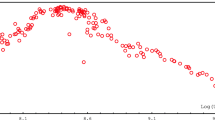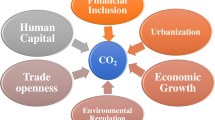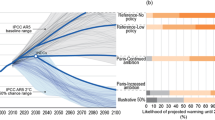Abstract
This study begins with a brief presentation of the Neoclassical Model of economic growth and continues with the inclusion of two additional variables that affect welfare in opposing ways: pollution and abatement expenditures. The optimal steady-state conditions are derived allowing for a preliminary comparison of the resulting balanced growth paths under the criterion of welfare maximization with and without environmental externalities. Finally, using a balanced panel data of 43 countries and for the time period 1990–2011 we test the validity of including the environment in the neoclassical growth model approximating pollution abatement with the electricity production from renewable sources and pollution with carbon dioxide emissions. With the help of adequate econometric panel data methods we test the validity of the environmental Kuznets curve hypothesis for the full sample, as well as for the OECD and non-OECD countries.


Similar content being viewed by others
Notes
López-Menéndez et al. (2014) provide a review of the findings of the EKC empirical studies.
It is typical to measure output in value terms of a single composite good whose price is set equal to 1. Thus, the final good becomes a measure of comparison of values for all other goods and services whose price is expressed in units of the final good (numéraire).
Generally, the term ‘physical capital’ includes all accumulated or produced factors of production which are themselves output of some productive process.
Given that the economy is closed, total savings is equal to total investment.
The last case describes a situation defined as the steady state of the model.
Note that all variables depend on time even though the time subscript is omitted whenever time dependence is easily understood.
This guarantees a constant level of pollution in steady state.
Notice that the additional term in (19) is the (constant) ratio of per-capita abatement expenditures \( b \), over per-capita physical capital \( k \).
Another variable of interest for our purpose was the greenhouse gases (GHG) net emissions/removals by LUCF (in Mt of CO2 equivalent) referring to changes in levels of all GHG attributable to forest and land-use change activities. Due to many missing values this variable was omitted from our analysis.
The full sample database used has 946 observations per variable. The countries used are the following: OECD countries (n = 21): Australia, Austria, Canada, Chile, Denmark, Finland, France, Greece, Ireland, Italy, Japan, Korea, Luxembourg, Mexico, The Netherlands, Norway, Portugal, Sweden, Turkey, UK, USA Non-OECD countries (n = 22): Argentina, Bolivia, Brazil, China, Colombia, Costa Rica, Caribbean, Cuba, Dominican Rep, Gabon, Guatemala, Indonesia, Nicaragua, Panama, Peru, Philippines, Senegal, Singapore, El Salvador, Thailand, Trinidad and Tobago, Uruguay.
For more details see http://data.worldbank.org/indicator/NY.GNP.PCAP.CD.
The source of data is IEA Statistics © OECD/IEA 2012 (http://www.iea.org/stats/index.asp), subject to https://www.iea.org/t&c/termsandconditions/.
For more details see Halkos (2011).
STATA’s “xtcsd” command was used (De Hoyos and Sarafidis 2006).
Fisher type tests are based on combining the p values of the N cross-sectional tests rather than using appropriately scaled cross-sectional averages of the N independent test statistics (Verbeek 2005).
As mentioned before, our dynamic model specification was reduced to an autoregressive distributed lag model [AD(1,0)], which for simplicity is called dynamic.
The latter comes in line with the two-step Sargan test statistic. Additionally, for all specifications we test the validity of instruments with the Hansen test failing to reject the null hypothesis.
The long-run coefficients of the GMM estimates may be calculated by dividing each estimated short-run coefficient by one minus the coefficient of the lagged dependent variable.
References
Akao KI (2014) Preference constraint for sustainable development. Environ Econ Policy Stud 16(4):343–357
Akbostanci E, Turut-Asik S, Tunc GI (2009) The relationship between income and environment in Turkey: is there an environmental Kuznets curve. Energy Policy 37:861–867
Andreoni J, Levinson A (2001) The simple analytics of the environmental Kuznets curve. J Public Econ 80:269–286
Ansuategi A, Barbier EB, Perrings CA (1998) The environmental Kuznets curve. In: Van den Bergh JCJM, Hofkes MW (eds) Theory and implementation of economic models for sustainable development. Kluwer, Berlin
Arellano M (1988) ‘An alternative transformation for fixed effects models with predetermined variables’, Mimeo. Institute of Economics and Statistics, Oxford
Arellano M, Bond S (1998) Dynamic panel data estimation using DPD98 for GAUSS, Mimeo. Institute for Fiscal Studies, London
Arrow K, Bolin B, Costanza R, Dasgupta P, Folke C, Holling CS, Jansson BO, Levin S, Maler KG, Perrings C, Pimentel D (1995) Economic growth, carrying capacity and the environment. Science 268:520–521
Baltagi BH (2001) Economic analysis of panel data, 2nd edn. Wiley, New York
Barbieri L. (2006). Panel Unit Root Tests: A Review. Quaderni del Dipartimento di Scienze Economiche e Sociali, Serie Rossa, n. 43, Università Cattolica del Sacro Cuore, Piacenza
Breitung J (2000) The local power of some unit root tests for panel data. In: Baltagi BH (ed) Nonstationary panels, panel cointegration and dynamic panels, advances in econometrics. JAI, Amsterdam
Breitung J, Das S (2005) Panel unit root tests under cross sectional dependence. Stat Neerl 59:414–433
Brock WA, Taylor MS (2005) Economic growth and the environment: a review of theory and empirics. In: Aghion P, Durlauf SN (eds) Handbook of economic growth 1B, chapter 28, pp 1749–1821. Amsterdam
Camarero M, Gómez E, Tamarit C (2011) Evidence of the Euro effect on trade estimating gravity equations with panel cointegration techniques. http://www.revecap.com/encuentros/trabajos/c/pdf/005.pdf
Cass D (1965) Optimum growth in an aggregative model of capital accumulation. Rev Econ Stud 32:233–240
Chuku A (2011) Economic development and environmental quality in Nigeria: is there an environmental Kuznets curve? MPRA Paper 30195. University Library of Munich, Germany
Cole MA, Rayner AJ, Bates JM (1997) The Environmental Kuznets curve: an empirical analysis. Environ Dev 2(4):401–416
De Bruyn SM (1997) Explaining the environmental Kuznets curve: structural change and international agreements in reducing sulphur emissions. Environ Dev Econ 2(4):485–503
De Hoyos RE, Sarafidis V (2006) Testing for cross-sectional dependence in panel-data models. Stat J 6:482–496
Dinda S (2004) Environmental Kuznets curve hypothesis: a survey. Ecol Econ 49:431–455
Dinda S, Coondos D, Pal M (2000) Air quality and economic growth: an empirical study. Ecol Econ 34:409–423
Ekins P (1997) The Kuznets curve for the environment and economic growth: examining the evidence. Environ Plan 29:805–830
Everett T, Ishwaran M, Ansaloni GP, Rubin A (2010) Economic growth and the environment, MPRA Paper 23585. University Library of Munich, Germany
Fodha M, Zaghdoud O (2010) Economic growth and pollution emissions in Tunisia: an empirical analysis of the environmental Kuznets curve. Energy Policy 38:1150–1156
Friedl B, Getzner M (2003) Determinants of CO2 emissions in a small open economy. Ecol Econ 45:133–148
Galeotti M, Lanza A, Pauli F (2006) Reassessing the environmental Kuznets curve for CO2 emissions: a robustness exercise. Ecol Econ 57:152–163
Grossman G, Krueger A (1995) Economic growth and the environment. Quart J Econ 110:353–377
Hadri K (2000) Testing for stationarity in heterogeneous panel data. Econom J 3(2):148–161
Halkos GE (2003) Environmental Kuznets curve for sulphur: evidence using GMM estimation. Environ Dev Econ 8:581–601
Halkos GE (2011) Econometrics: theory and practice, instructions in using eviews, Minitab, SPSS and Excel. Gutenberg
Halkos GE (2012) Environmental pollution and economic development: explaining the existence of an environmental Kuznets curve. J Appl Econ Sci 6(18):148–159
Halkos GE (2014) The economics of climate change policy: critical review and future policy directions, MPRA Paper 56841. University Library of Munich, Munich
Halkos GE (2015) Climate change actions for sustainable development. Int J Innov Sustain Dev 9:118–136
Halkos GE, Tsionas EG (2001) Environmental Kuznets curves: Bayesian evidence from switching regime models. Energy Econ 23(2):191–210
Han X, Chatterjee L (1997) Impacts of growth and structural change on CO2 emissions of developing countries. World Dev 25:395–407
Harris RDF, Tzavalis E (1999) Inference for unit roots in dynamic panels where the time dimension is fixed. J Econom 91:201–226
He J, Richard P (2010) Environmental Kuznets curve for CO2 in Canada. Ecol Econ 69:1083–1093
Holtz-Eakin D, Selden TM (1995) Stoking the fires: CO2 emissions and economic growth. J Public Econ 57:85–101
Hsiao C (1986) Analysis of panel data. Cambridge University Press, Cambridge
Im KS, Pesaran MH, Shin Y (2003) Testing for unit roots in heterogeneous panels. J Econom 115:53–74
Koopmans TC (1965) On the concept of optimal economic growth in the econometric approach to development planning. Amsterdam
Levin A, Lin CF, Chu CS (2002) Unit root tests in panel data: asymptotic and finite-sample properties. J Econom 108:1–24
Lieb CM (2003) The environmental Kuznets curve: a survey of the empirical evidence and the possible causes. University of Heidelberg Depart of Economics, Discussion Paper Series No. 391
Lopez R (1994) The environment as a factor of production: the effects of economic growth and trade liberalization. J Environ Econ Manag 27:163–184
López-Menéndez AJ, Pérez R, Moreno B (2014) Environmental costs and renewable energy: re-visiting the environmental Kuznets curve. J Environ Manag 145:368–373
Lucas RE Jr (1988) On the mechanics of economic development. J Monet Econ 22:3–42
Managi S, Kaneko S (2006) Productivity of market and environmental abatement in China. Environ Econ Policy Stud 7(4):459–470
Martínez-Zarzoso I, Bengochea-Morancho A (2004) Pooled mean group estimation of an environmental Kuznets curve for CO2. Econ Lett 82(1):121–126
McConnell KE (1997) Income and demand for environmental quality. Environ Dev Econ 2:383–399
Meadows DH, Meadows DL, Randers J, Behrens WW III (1972) The limits to growth: a report for the Club of Rome’s project on the predicament of mankind. Potomac Associates, Washington DC
Mundlak Y (1978) On the pooling of time series and cross section data. Econometrica 46:69–85
Panayotou T (1993) Empirical tests and policy analysis of environmental degradation at different stages of economic development. Working Paper WP238, Technology and Employment Programme, International Labour Office, Geneva
Panayotou T (1997) Demystifying the environmental Kuznets curve: turning a black box into a policy tool. Environ Dev Econ 2(4):465–484
Pedroni P (1999) Critical values for cointegrating tests in heterogeneous panel with multiple regressors. Oxford Bull Econ Stat 61:653–678
Pedroni PL (2000) Fully modified OLS for heterogeneous cointegrated panels nonstationary panels. Panel Cointegr Dyn Panels 15:93–130
Pedroni PL (2004) Panel cointegration: asymptotic and finite sample properties of pooled time series tests with an application to the purchasing power parity hypothesis. Econom Theory 20:597–625
Perman R, Stern DI (1999) The environmental Kuznets curve: implications of non-stationarity, Working Papers in Ecological Economics 9901, Center for Resource and Environmental Studies, Australian National University
Pesaran MH (2004) General diagnostic tests for cross section dependence in panels. CESifo Working Papers, No. 1229
Ramsey FP (1928) A mathematical theory of saving. Econ J 38:543–559
Roca J, Padilla E, Farre M, Galletto V (2001) Economic growth and atmospheric pollution in Spain: discussing the environmental Kuznets hypothesis. Ecol Econ 39:85–99
Romer PM (1990) Endogenous technological change. J Polit Econ 98(5): part 2, S71–S102
Shafik N, Bandyopadhyay S (1992) Economic growth and environmental quality: time series and cross-country evidence, Background paper for the World Development Report 1992. The World Bank, Washington DC
Solow RM (1956) A contribution to the theory of economic growth. Quart J Econ 70(1):65–94
Stern DI (1998) Progress on the environmental Kuznets curve? Environ Dev Econ 3:175–198
Stern N (2007) The economics of climate change: the stern review. Cambridge University Press, Cambridge
Stern DI, Common MS (2001) Is there an environmental Kuznets curve for sulphur? J Environ Econ Manag 41:162–178
Stern DI, Common MS, Barbier EB (1996) Economic growth and the environmental degradation: the environmental Kuznets curve and sustainable development. World Dev 24:1151–1160
Stokey NL (1998) Are there limits to growth? Int Econ Rev 39:1–31
Swan TW (1956) Economic growth and capital accumulation. Econ Rec 32:334–361
Tsurumi T, Managi S (2010) Decomposition of the environmental Kuznets curve: scale, technique, and composition effects. Environ Econ Policy Stud 11(1):19–36
Verbeek M (2005) A guide to modern econometrics, 2nd edn. Wiley, England
Xepapadeas A (2005) Economic growth and the environment. In: Mäler KG, Vincent JR (ed) Handbook of environmental economics, vol 3, Chapter 23, pp 1220–1271. Amsterdam
Author information
Authors and Affiliations
Corresponding author
About this article
Cite this article
Halkos, G., Psarianos, I. Exploring the effect of including the environment in the neoclassical growth model. Environ Econ Policy Stud 18, 339–358 (2016). https://doi.org/10.1007/s10018-016-0146-5
Received:
Accepted:
Published:
Issue Date:
DOI: https://doi.org/10.1007/s10018-016-0146-5




